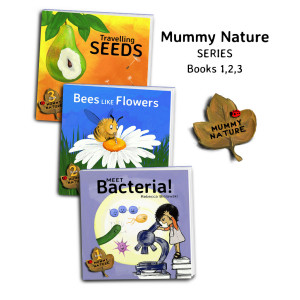“Nurturing Nature in the Classroom”
If you are having trouble getting your class out and into nature, there are a hundred ways you can get nature into your class. If you want your kids to run wild with nature-based crafts and projects, but your imagination feels as dried up as an autumn leaf, don’t despair – On the wonderful world wide web you can discover all the inspiration you need. I especially recommend Pinterest boards and Google+ communities to look for specific ideas suited to your group’s age and other circumstances.
Here are a few tips for adapting nature projects and nature crafts that you might find, to your own classroom or home school environment.
Adapt ideas to your local area e.g., seeds to germinate that are readily and cheaply available, plants that are easy to sprout and suited to the climate and of course child friendly. Your local garden centre can help out. Local plant species will always be more relevant to the kids. (Planting sunflowers was my favourite as a kid.)
Adapt ideas to your available resources Most projects will not represent an elevated cost. Here you can use recycled materials such as plastic bottles and yoghurt pots, eg. hand trowels can be made from plastic milk or juice bottles with handles. You can also reinforce the Reuse, Reduce Recycle mantra. If you have more of a budget you could, for example, buy plants for the classroom that represent your nature goals.
Don’t forget about your human resources Think about, how many people you have available to help out. Don’t be afraid to ask parents, grannies etc. for help. Get to know a bit about them, what sector do they work in, do they have any interesting hobbies or contacts? Find out who has the wildest back yard and if they need it to be explored. They will be able to help in a million ways with their expertise or simply their time and enthusiasm.
Plan an excursion Think about what nature opportunities are offered by the surrounding countryside. Go with someone who has knowledge of the local plant life, to enrich the visit and be aware of dangerous or poisonous plants.
It’s great if you can go out to a local forest or mountain or other wild habitat but if that presents too much of a logistical or safety problem, even a local park or a corner of the playground can be ideal to focus on one point of interest, for tiny discoveries inside the grounds of the school. Take them to see the weeds growing out of the cracks in the pavement. They can track how fast they grow, pull them out to observe the roots or discuss flowering or seed dispersal. There is a lot to be learnt from the bugs under the rocks too, eg. observational drawings, questions: Why do they live there? What are they doing? Identify and compare species… Finding moss and lichen and other treasures is another option.
Plan ahead and imagine what restriction or problems you might encounter during the activity, especially if you are the only adult involved.
Here are a few juicy nature ideas to get you started:
Flower spotting
Flower pressing
Flower arrangements
Vaseline saucers – you put a thin layer of vaseline on a small plate and make circular patterns with different petal and small leaves
Finding animal tracks, burrows, nests
Collecting seed pods, cones, feathers, sticks, bark, leaves to make their own nests, collages, miniature habitats
Worm collecting for a class compost bin where the kids can throw their biodegradable rubbish from their snacks
Have a “dirty day.” In rural schools, everyday is pretty much a dirty day, but urban schools might find the concept more of a novelty and very liberating – Kids come with old clothes and can play in the dirt, make mud pies and are allowed to get as dirty as they want
Remember, the opportunities to bring our little ones closer to their natural surrounding can be found in every corner. Happy worm hunting!
About the Author: Rebecca Bielawski is the author of the educational series of children’s books MUMMY NATURE, designed for home and classroom use for under 6yrs. With a background in biology, nutrition, art and graphic design. She grew up in rural New Zealand, and now lives in the south of Spain where she is involved in a community project teaching English to Spanish children through stories, games, arts and crafts. http://www.booksbeck.com/
About the Series: Each book in the series is one mini nature lesson wrapped up in colour and rhyme. These books are intended for very young children including toddlers and will give them just a glimpse into some of the wonders of the natural world. Illustrated for maximum vibrancy and visual impact, using rhyme to engage young minds and encourage participation. Read the rhymes to your children and soon they will be reading them to you!
The narrator is a small child and keen observer who tells us in short rhyming phrases everything she thinks we should know, and all about the magical things she sees around her. Sometimes she is camouflaged in the long grass and other times she has to climb a tree to get a better look.
Review of Meet Bacteria (Mummy Nature Book 1) here at Unleashing Readers: This book is a great introduction to scientific exploration and then to bacteria itself. I love that the protagonist is a young girl who is exploring the world around her. I think students will see themselves in her, and that along with the interesting, rhyming information about the different types of bacteria will really persuade kids to want to explore.
I do think that this is just an introduction though. Each bacteria is briefly mentioned along with a fun illustration. I would love to see this book be a jumping off point to an inquiry unit about bacteria.
Thank you Rebecca for tips on how to connect our kids/students with nature from such a young age!


